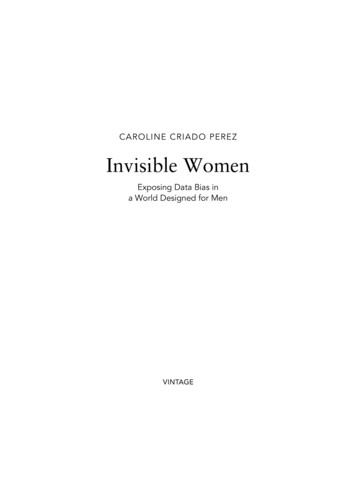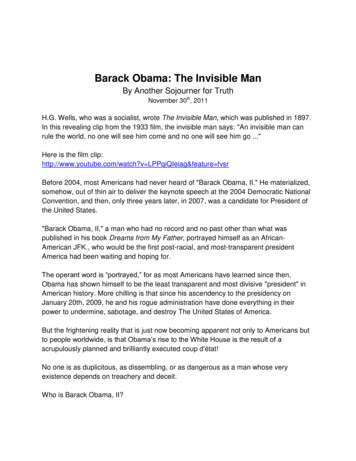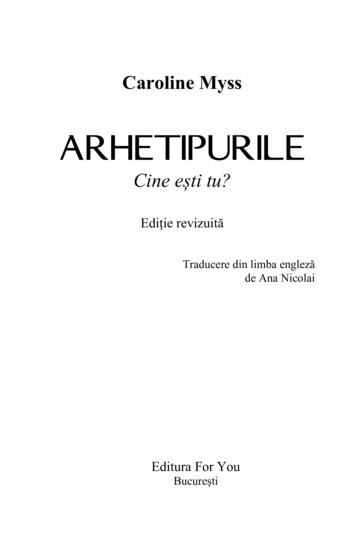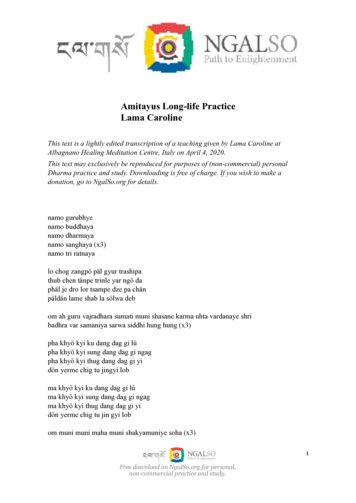
Transcription
CAROLINE CRIADO PEREZInvisible WomenExposing Data Bias ina World Designed for Men
1 3 5 7 9 10 8 6 4 2Vintage20 Vauxhall Bridge Road,London SW1V 2SAVintage is part of the Penguin Random House groupof companies whose addresses can be foundat global.penguinrandomhouse.comCopyright Caroline Criado Perez 2019Caroline Criado Perez has asserted her right to beidentified as the author of this Work in accordancewith the Copyright, Designs and Patents Act 1988First published in Vintage in 2020First published in hardback by Chatto & Windus in 2019penguin.co.uk/vintageA CIP catalogue record for this book is availablefrom the British LibraryISBN 9781784706289Printed and bound in Great Britain by Clays Ltd, Elcograf S.p.A.Penguin Random House is committed to a sustainable futurefor our business, our readers and our planet. This book ismade from Forest Stewardship Council certified paper.For the wom
PrefaceMost of recorded human history is one big data gap. Starting withthe theory of Man the Hunter, the chroniclers of the past have leftlittle space for women’s role in the evolution of humanity, whethercultural or biological. Instead, the lives of men have been taken torepresent those of humans overall. When it comes to the lives of theother half of humanity, there is often nothing but silence.And these silences are everywhere. Our entire culture is riddledwith them. Films, news, literature, science, city planning, economics. The stories we tell ourselves about our past, present and future.They are all marked – disfigured – by a female-shaped ‘absent presence’. This is the gender data gap.The gender data gap isn’t just about silence. These silences, thesegaps, have consequences. They impact on women’s lives every day.The impact can be relatively minor. Shivering in offices set to a maletemperature norm, for example, or struggling to reach a top shelfset at a male height norm. Irritating, certainly. Unjust, undoubtedly.But not life-threatening. Not like crashing in a car whose safetymeasures don’t account for women’s measurements. Not like havingxi
xiiInvisible Womenyour heart attack go undiagnosed because your symptoms are deemed‘atypical’. For these women, the consequences of living in a world builtaround male data can be deadly.One of the most important things to say about the gender datagap is that it is not generally malicious, or even deliberate. Quitethe opposite. It is simply the product of a way of thinking that hasbeen around for millennia and is therefore a kind of not thinking.A double not thinking, even: men go without saying, and womendon’t get said at all. Because when we say human, on the whole, wemean man.This is not a new observation. Simone de Beauvoir made itmost famously when in 1949 she wrote, ‘humanity is male andman defines woman not in herself, but as relative to him; she is notregarded as an autonomous being. [. . .] He is the Subject, he is theAbsolute – she is the Other.’1 What is new is the context in whichwomen continue to be ‘the Other’. And that context is a worldincreasingly reliant on and in thrall to data. Big Data. Which in turnis panned for Big Truths by Big Algorithms, using Big Computers.But when your big data is corrupted by big silences, the truths youget are half-truths, at best. And often, for women, they aren’t trueat all. As computer scientists themselves say: ‘Garbage in, garbageout.’This new context makes the need to close the gender data gapever more urgent. Artificial intelligence that helps doctors withdiagnoses, that scans through CVs, even that conducts interviewswith potential job applicants, is already common. But AIs have beentrained on data sets that are riddled with data gaps – and becausealgorithms are often protected as proprietary software, we can’t evenexamine whether these gaps have been taken into account. On theavailable evidence, however, it certainly doesn’t look as if they have.Numbers, technology, algorithms, all of these are crucial to thestory of Invisible Women. But they only tell half the story. Datais just another wsources. Statisticsexperience. And sthat is meant toIf the people takable-bodied menconstitutes a datamation on femaleI will show, failindriver of an uninfaith) to pass itsemeant when shewith the absoluteThe female-spewide variety of athemes crop up acare burden, andof such significanlives, affecting outo politics, via thforget them, becawill see, do only awhile they do hava different way toferences go ignorattendant life expcrimination againThroughout thiI mean the bioloindividual is malesocial meanings wwomen are treate
ptoms are deemeding in a world builtt the gender datadeliberate. Quitethinking that hasd of not thinking.ying, and womenon the whole, weBeauvoir made itanity is male andto him; she is notSubject, he is thecontext in whichontext is a worldata. Which in turng Big Computers.es, the truths youn, they aren’t truerbage in, garbagee gender data gapelps doctors withnducts interviewsBut AIs have beenps – and becauseare, we can’t eveno account. On theok as if they have.are crucial to thef the story. DataPrefacexiiiis just another word for information, and information has manysources. Statistics are a kind of information, yes, but so is humanexperience. And so I will argue that when we are designing a worldthat is meant to work for everyone we need women in the room.If the people taking decisions that affect all of us are all white,able-bodied men (nine times out of ten from America), that tooconstitutes a data gap – in the same way that not collecting information on female bodies in medical research is a data gap. And asI will show, failing to include the perspective of women is a hugedriver of an unintended male bias that attempts (often in goodfaith) to pass itself off as ‘gender neutral’. This is what de Beauvoirmeant when she said that men confuse their own point of viewwith the absolute truth.The female-specific concerns that men fail to factor in cover awide variety of areas, but as you read you will notice that threethemes crop up again and again: the female body, women’s unpaidcare burden, and male violence against women. These are issuesof such significance that they touch on nearly every part of ourlives, affecting our experiences of everything from public transportto politics, via the workplace and the doctor’s surgery. But menforget them, because men do not have female bodies. They, as wewill see, do only a fraction of the unpaid work done by women. Andwhile they do have to contend with male violence, it manifests ina different way to the violence faced by women. And so these differences go ignored, and we proceed as if the male body and itsattendant life experience are gender neutral. This is a form of discrimination against women.Throughout this book I will refer to both sex and gender. By ‘sex’,I mean the biological characteristics that determine whether anindividual is male or female. XX and XY. By ‘gender’, I mean thesocial meanings we impose upon those biological facts – the waywomen are treated because they are perceived to be female. One
xivInvisible Womenis man-made, but both are real. And both have significant consequences for women as they navigate this world constructed on maledata.But although I talk about both sex and gender throughout, Iuse gender data gap as an overarching term because sex is not thereason women are excluded from data. Gender is. In naming thephenomenon that is causing so much damage to so many women’slives, I want to be clear about the root cause and, contrary to manyclaims you will read in these pages, the female body is not theproblem. The problem is the social meaning that we ascribe to thatbody, and a socially determined failure to account for it.Invisible Women is a story about absence – and that sometimesmakes it hard to write about. If there is a data gap for women overall(both because we don’t collect the data in the first place and becausewhen we do we usually don’t separate it by sex), when it comes towomen of colour, disabled women, working-class women, the datais practically non-existent. Not simply because it isn’t collected,but because it is not separated out from the male data – what iscalled ‘sex-disaggregated data’. In statistics on representation fromacademic jobs to film roles, data is given for ‘women’ and ‘ethnicminorities’, with data for female ethnic minorities lost within eachlarger group. Where they exist, I have given them – but they barelyever do.The point of this book is not psychoanalysis. I do not have directaccess to the innermost thoughts of those who perpetuate the gender data gap, which means that this book cannot provide ultimateproof for why the gender data gap exists. I can only present youwith the data, and ask you as a reader to look at the evidence. Butnor am I interested in whether or not the person who produced amale-biased tool was a secret sexist. Private motivations are, to acertain extent, irrelevant. What matters is the pattern. What matters is whether, given the weight of the data I will present, it isreasonable to concoincidence.I will argue this both a cause aconceives of humoften and how wsupposedly objecshow that even isuper-impartial sBeauvoir’s Secondat best, a sub-typ
significant consenstructed on maleder throughout, Iuse sex is not theis. In naming theso many women’scontrary to manye body is not thewe ascribe to thatt for it.d that sometimesfor women overallplace and becausewhen it comes towomen, the datait isn’t collected,le data – what ispresentation fromomen’ and ‘ethnics lost within each– but they barelydo not have directerpetuate the gent provide ultimateonly present youthe evidence. Butn who produced ativations are, to aattern. What matwill present, it isPrefacexvreasonable to conclude that the gender data gap is all just one bigcoincidence.I will argue that it is not. I will argue that the gender data gapis both a cause and a consequence of the type of unthinking thatconceives of humanity as almost exclusively male. I will show howoften and how widely this bias crops up, and how it distorts thesupposedly objective data that increasingly rules our lives. I willshow that even in this super-rational world increasingly run bysuper-impartial supercomputers, women are still very much deBeauvoir’s Second Sex – and that the dangers of being relegated to,at best, a sub-type of men, are as real as they have ever been.
Introduction: The Default MaleSeeing men as the human default is fundamental to the structureof human society. It’s an old habit and it runs deep – as deep astheories of human evolution itself. In the fourth century bc Aristotlewas already baldly articulating male default as unarguable fact:‘The first departure from type is indeed that the offspring shouldbecome female instead of male’, he wrote in his biological treatiseOn the Generation of Animals. (He did allow that this aberrationwas, however, ‘a natural necessity’.)Over two thousand years later, in 1966, the University of Chicagoheld a symposium on primitive hunter-gatherer societies. It wascalled ‘Man the Hunter’. Over seventy-five social anthropologistsfrom around the world gathered to debate the centrality of hunting to human evolution and development. The consensus was thatit is pretty central.1 ‘The biology, psychology, and customs that separate us from the apes – all these we owe to the hunters of timepast’, claimed one of the papers published in the resulting book.Which is all very well, only, as feminists pointed out, this theoryposes something of a problem for female evolution. Because, as the1
2Invisible Womenbook made clear, hunting was a male activity. So if ‘our intellect,interests, emotions, and basic social life – all are evolutionary products of the success of hunting adaptation’, what does that meanfor women’s humanity? If human evolution is driven by men, arewomen even human?In her now classic 1975 essay, ‘Woman the Gatherer’, anthropologist Sally Slocum challenged the primacy of ‘Man the Hunter’.2Anthropologists, she argued, ‘search for examples of the behaviourof males and assume that this is sufficient for explanation’. Andso she asked a simple question to fill the silence: ‘what were thefemales doing while the males were out hunting?’ Answer: gathering, weaning, caring for children during ‘longer periods of infantdependency’, all of which would similarly have required cooperation. In the context of this knowledge, the ‘conclusion that thebasic human adaptation was the desire of males to hunt and kill,’objects Slocum, ‘gives too much importance to aggression, which isafter all only one factor of human life.’Slocum made her critique over forty years ago now, but themale bias in evolutionary theory persists. ‘Humans evolved tohave an instinct for deadly violence, researchers find’, read a2016 headline in the Independent. 3 The article reported on anacademic paper called ‘The phylogenetic roots of human lethalviolence’, which claimed to reveal that humans have evolved tobe six times more deadly to their own species than the averagemammal.4This is no doubt true of our species overall – but the reality ofhuman-on-human lethal violence is that it is overwhelmingly a maleoccupation: a thirty-year analysis of murder in Sweden found thatnine out of ten murders are committed by men.5 This holds with statistics from other countries, including Australia,6 the UK7 and theUS.8 A 2013 UN homicide survey found that 96% 9 of homicide perpetrators worldwide are male. So is it humans who are murderous,or men? And if woto think of femaleThe male-unlesto have infectedfor example, areassumed they weof handprints thaFrance and Spaindone by women.10Even human bwise-indicated thbeing objectivelymale-default thinyears, a tenth-cenrior’ had – despitassumed to be mweapons and twothat the occupan(archaeologists puViking lore downweapons apparendon’t trump DNAdid indeed belongThe argumentbones might hava female body wmight have a poiof the grave conteBut the resistanceskeletons in similway’.15 Indeed, whalways find more
o if ‘our intellect,volutionary prodt does that meaniven by men, areherer’, anthropolMan the Hunter’.2s of the behaviourexplanation’. Ande: ‘what were the’ Answer: gatherperiods of infantrequired coopernclusion that theto hunt and kill,’gression, which isago now, but themans evolved toers find’, read ae reported on anof human lethals have evolved tothan the averagebut the reality ofwhelmingly a maleweden found thatThis holds with stathe UK7 and the9of homicide perho are murderous,Introduction: The Default Male3or men? And if women aren’t on the whole murdering, what are weto think of female ‘phylogenetics’?The male-unless-otherwise-indicated approach to research seemsto have infected all sorts of ethnographic fields. Cave paintings,for example, are often of game animals and so researchers haveassumed they were done by men – the hunters. But new analysisof handprints that appear alongside such paintings in cave sites inFrance and Spain has suggested that the majority were actuallydone by women.10Even human bones are not exempt from male-unless-otherwise-indicated thinking. We might think of human skeletons asbeing objectively either male or female and therefore exempt frommale-default thinking. We would be wrong. For over a hundredyears, a tenth-century Viking skeleton known as the ‘Birka warrior’ had – despite possessing an apparently female pelvis – beenassumed to be male because it was buried alongside a full set ofweapons and two sacrificed horses.11 These grave contents indicatedthat the occupant had been a warrior12 – and warrior meant male(archaeologists put the numerous references to female fighters inViking lore down to ‘mythical embellishments’13). But althoughweapons apparently trump the pelvis when it comes to sex, theydon’t trump DNA and in 2017 testing confirmed that these bonesdid indeed belong to a woman.The argument didn’t, however, end there. It just shifted.14 Thebones might have been mixed up; there might be other reasonsa female body was buried with these items. Naysaying scholarsmight have a point on both counts (although based on the layoutof the grave contents the original authors dismiss these criticisms).But the resistance is nevertheless revealing, particularly since maleskeletons in similar circumstances ‘are not questioned in the sameway’.15 Indeed, when archaeologists dig up grave sites, they nearlyalways find more males, which, as noted anthropologist Phillip
4Invisible WomenWalker drily noted in a 1995 book chapter on sexing skulls, is ‘notconsistent with what we know about the sex ratios of extant humanpopulations’.16 And given Viking women could own property, couldinherit and could become powerful merchants, is it so impossiblethat they could have fought too?17After all, these are far from the only female warrior bones thathave been discovered. ‘Battle-scarred skeletons of multiple womenhave been found across the Eurasian steppes from Bulgaria toMongolia’ wrote Natalie Haynes in the Guardian.18 For people suchas the ancient Scythians, who fought on horseback with bows andarrows, there was no innate male warrior advantage, and DNAtesting of skeletons buried with weapons in more than 1,000 Scythian burial mounds from Ukraine to Central Asia have revealed thatup to 37% of Scythian women and girls were active warriors.19The extent to which male-unless-otherwise-indicated permeatesour thinking may seem less surprising when you realise that it isalso embedded in one of the most basic building blocks of society:language itself. Indeed, when Slocum criticised male bias in anthropology, she pointed out that this bias appeared ‘not only in the waysin which the scanty data are interpreted, but in the very languageused’. The word ‘man’, she wrote, ‘is used in such an ambiguousfashion that it is impossible to decide whether it refers to males orto the human species in general’. This collapse in meaning led Slocum to suspect that ‘in the minds of many anthropologists, ‘man’,supposedly meaning the human species, is actually exactly synonymous with ‘males’. As we shall see, the evidence suggests that shewas probably right.In Muriel Rukeyser’s poem ‘Myth’, an old, blind Oedipus asksthe Sphinx, ‘Why didn’t I recognize my mother?’ The Sphinxreplies that Oedipus answered her question (what walks on fourlegs in the morning, two in the afternoon and three in the evening)incorrectly. ‘[Y]ou answered, Man. You didn’t say anything aboutwoman.’ But, repwomen too. EveryBut in fact theyou say man youtechnically ‘knowover the past fortythe ‘generic mascway) is not in facmale.When the genrecall famous menmale-dominated;2appointments.23 Wto perform well ithe generic mascoverwhelmingly astereotypes, so thally stereotyped fescientific studies,paper looking atthat the use of twomen’s responsscores’.26 The autdifferences betweein the gender-neuthe same questionAnd yet in thmasculine is anycountries continumust continue foAcadémie françalanguage, was th
xing skulls, is ‘nots of extant humanwn property, coulds it so impossiblewarrior bones thatf multiple womenfrom Bulgaria to18For people suchck with bows andntage, and DNAhan 1,000 Scythhave revealed thatve warriors.19dicated permeatesu realise that it isblocks of society:ale bias in anthrot only in the waysthe very languagech an ambiguousrefers to males ormeaning led Sloopologists, ‘man’,lly exactly synonsuggests that sheind Oedipus asksher?’ The Sphinxhat walks on fouree in the evening)y anything aboutIntroduction: The Default Male5woman.’ But, replies Oedipus, when you say man, ‘you includewomen too. Everyone knows that.’But in fact the Sphinx was right and Oedipus is wrong. Whenyou say man you don’t ‘include women too’, even if everyone doestechnically ‘know that’. Numerous studies in a variety of languagesover the past forty years have consistently found that what is calledthe ‘generic masculine’ (using words like ‘he’ in a gender-neutralway) is not in fact read generically.20 It is read overwhelmingly asmale.When the generic masculine is used people are more likely torecall famous men than famous women;21 to estimate a profession asmale-dominated;22 to suggest male candidates for jobs and politicalappointments.23 Women are also less likely to apply, and less likelyto perform well in interviews, for jobs that are advertised usingthe generic masculine.24 In fact the generic masculine is read sooverwhelmingly as male that it even overrides otherwise powerfulstereotypes, so that professions such as ‘beautician’, which are usually stereotyped female, are suddenly seen as male.25 It even distortsscientific studies, creating a kind of meta gender data gap: a 2015paper looking at self-report bias in psychological studies foundthat the use of the generic masculine in questionnaires affectedwomen’s responses, potentially distorting ‘the meaning of testscores’.26 The authors concluded that its use ‘may portray unrealdifferences between women and men, which would not appearin the gender-neutral form or in natural gender language versions ofthe same questionnaire’.And yet in the face of decades of evidence that the genericmasculine is anything but clear, official language policy in manycountries continues to insist that it is purely a formality whose usemust continue for the sake of . . . clarity. As recently as 2017, theAcadémie française, France’s ultimate authority on the Frenchlanguage, was thundering against ‘the aberration of “inclusive
6Invisible Womenwriting” ’, claiming that ‘the French language finds itself in mortaldanger’ from workarounds for the generic masculine. Other countries including Spain27 and Israel28 have faced similar rows.Because English is not a grammatically gendered language, thegeneric masculine is fairly restricted in modern usage. Terms like‘doctor’ and ‘poet’ used to be generic masculine (with specificallyfemale doctors and poets referred to – usually derisively – aspoetesses and doctoresses), but are now considered gender neutral. Butwhile the formal use of the generic masculine only really clings on inthe writings of pedants who still insist on using ‘he’ to mean ‘he or she’,it has made something of a comeback in the informal usage of Americanisms such as ‘dude’ and ‘guys’, and, in the UK, ‘lads’ as supposedlygender-neutral terms. A recent row in the UK also showed that, forsome, male default still matters an awful lot: when in 2017 the firstfemale head of London’s Fire Brigade, Dany Cotton, suggested that weshould replace ‘fireman’ with the now standard (and let’s face it, muchcooler) ‘firefighter’, she received a deluge of hate mail.29Languages such as French, German and Spanish, however, arewhat is called ‘gender-inflected’, and here the concept of masculineand feminine is woven into the language itself. All nouns are gendered either masculine or feminine. A table is feminine, but a caris masculine: la mesa roja (the red table); el coche rojo (the red car).When it comes to nouns that refer to people, while both male andfemale terms exist, the standard gender is always masculine. Trysearching Google for ‘lawyer’ in German. It comes back ‘Anwalt’,which literally means male lawyer, but is also used generically asjust ‘lawyer’. If you want to refer to a female lawyer specificallyyou would say ‘Anwältin’ (incidentally, the way female terms areoften, as here, modified male terms is another subtle way we position the female as a deviation from male type – as, in de Beauvoir’sterms, ‘Other’). The generic masculine is also used when referringto groups of people: when the gender is unknown, or if it’s a mixedgroup the genericfemale teachers inbut as soon as yobecomes ‘los profeIn gender-inflepervasive. Job vacforms – particulatrian study of theratio of masculinfemale term).31 Thsolution to this p‘(m/f)’ be added oThe idea is that treminding us thabacked up by datathat it made no dgeneric masculinelecting data and tDoes all this arArguably, yes. Inthat countries wiideas of masculinare the most uneqquirk: countries wFinnish) are not tthird group, counlish. These languamale nurse) but lThe study authorway you can’t ‘cor‘women’s presencsaying, it matters
ds itself in mortalline. Other counmilar rows.red language, theusage. Terms like(with specificallyy derisively – asgender neutral. Butreally clings on ino mean ‘he or she’,al usage of Ameriads’ as supposedlyo showed that, forn in 2017 the firstsuggested that wed let’s face it, muchil.29ish, however, arecept of masculineAll nouns are genminine, but a carrojo (the red car).ile both male andys masculine. Trymes back ‘Anwalt’,sed generically asawyer specificallyfemale terms arebtle way we posis, in de Beauvoir’sed when referring, or if it’s a mixedIntroduction: The Default Male7group the generic masculine is used. So a group of one hundredfemale teachers in Spanish would be referred to as ‘las profesoras’ –but as soon as you add a single male teacher, the group suddenlybecomes ‘los profesores’. Such is the power of the default male.In gender-inflected languages the generic masculine remainspervasive. Job vacancies are still often announced with masculineforms – particularly if they are for leadership roles.30 A recent Austrian study of the language used in leadership jobs ads found a 27:1ratio of masculine to ‘gender-fair forms’ (using both the male andfemale term).31 The European Parliament believes it has found asolution to this problem, and since 2008 has recommended that‘(m/f)’ be added on the end of job ads in gender-inflected languages.The idea is that this makes the generic masculine more ‘fair’ byreminding us that women exist. It’s a nice idea – but it wasn’tbacked up by data. When researchers did test its impact they foundthat it made no difference to the exclusionary impact of using thegeneric masculine on its own – illustrating the importance of collecting data and then creating policy.32Does all this arguing over words make any real world difference?Arguably, yes. In 2012, a World Economic Forum analysis foundthat countries with gender-inflected languages, which have strongideas of masculine and feminine present in almost every utterance,are the most unequal in terms of gender. 33 But here’s an interestingquirk: countries with genderless languages (such as Hungarian andFinnish) are not the most equal. Instead, that honour belongs to athird group, countries with ‘natural gender languages’ such as English. These languages allow gender to be marked (female teacher,male nurse) but largely don’t encode it into the words themselves.The study authors suggested that if you can’t mark gender in anyway you can’t ‘correct’ the hidden bias in a language by emphasising‘women’s presence in the world’. In short: because men go withoutsaying, it matters when women literally can’t get said at all.
8Invisible WomenIt’s tempting to think that the male bias that is embedded inlanguage is simply a relic of more regressive times, but the evidence does not point that way. The world’s ‘fastest-growinglanguage’,34 used by more than 90 % of the world’s online population, is emoji. 35 This language originated in Japan in the 1980sand women are its heaviest users:36 78% of women versus 60 %of men frequently use emoji. 37 And yet, until 2016, the world ofemojis was curiously male.The emojis we have on our smartphones are chosen by the rathergrand-sounding ‘Unicode Consortium’, a Silicon Valley-based groupof organisations that work together to ensure universal, international software standards. If Unicode decides a particular emoji (say‘spy’) should be added to the current stable, they will decide on thecode that should be used. Each phone manufacturer (or platformsuch as Twitter and Facebook) will then design their own interpretation of what a ‘spy’ looks like. But they will all use the same code,so that when users communicate between different platforms, theyare broadly all saying the same thing. An emoji face with heart eyesis an emoji face with heart eyes.Unicode has not historically specified the gender for most emojicharacters. The emoji that most platforms originally represented asa man running, was not called ‘man running’. It was just called‘runner’. Similarly the original emoji for police officer was describedby Unicode as ‘police officer’, not ‘policeman’. It was the individualplatforms that all interpreted these gender-neutral terms as male.In 2016, Unicode decided to do something about this. Abandoning their previously ‘neutral’ gender stance, they decided toexplicitly gender all emojis that depicted people.38 So instead of‘runner’ which had been universally represented as ‘male runner’,Unicode issued code for explicitly male runner and explicitly femalerunner. Male and female options now exist for all professions andathletes. It’s a small victory, but a significant one.It’s easy to slaforms as sexist (anbut the reality is tan image of a ‘geread that runnerunless they are sof course to be hto the idea thatand he’) insteadever happened tomasculine wouldembedded in ourare read as male.A 2015 study iple in human–cofound that they aperson, designerinteraction academparticipants wereten seconds and tapparently gendelikely to be malewas interpreted as70% male). A resgender than as abut on the whole was male, with on80% of male partiThis rather dishscientist’ data, whbias has historicacelebrated as grea
t is embedded inmes, but the evi‘fastest-growingld’s online popupan in the 1980smen versus 60 %016, the world ofosen by the ratherValley-based groupniversal, internarticular emoji (saywill decide on theurer (or platformheir own interprese the same code,nt platforms, theyce with heart eyesder for most emojilly represented asIt was just calledcer was describedwas the individuall terms as male.bout this. Abanthey decided toe.38 So instead ofas ‘male runner’,d explicitly femalell professions andIntroduction: The Default Male9It’s easy to slam phone manufacturers and social media platforms as sexist (and
increasingly reliant on and in thrall to data. Big Data. Which in turn is panned for Big Truths by Big Algorithms, using Big Computers. But when your big data is corrupted by big silences, the truths you get are half-truths, at best. And often, for women, they aren't true at all. As computer scientists themselves say: 'Garbage in, garbage .










